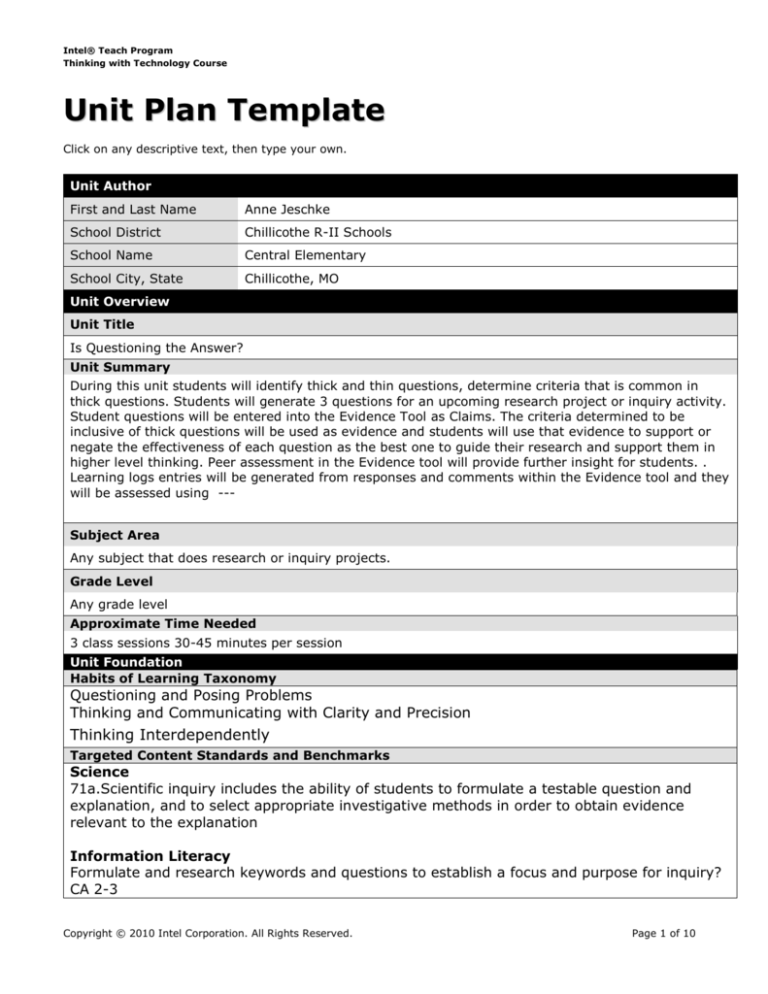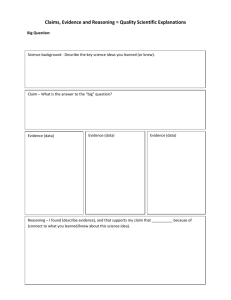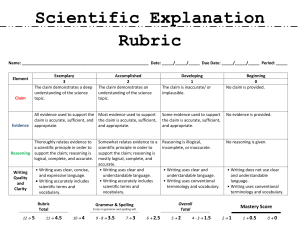
Intel® Teach Program
Thinking with Technology Course
Unit Plan Template
Click on any descriptive text, then type your own.
Unit Author
First and Last Name
Anne Jeschke
School District
Chillicothe R-II Schools
School Name
Central Elementary
School City, State
Chillicothe, MO
Unit Overview
Unit Title
Is Questioning the Answer?
Unit Summary
During this unit students will identify thick and thin questions, determine criteria that is common in
thick questions. Students will generate 3 questions for an upcoming research project or inquiry activity.
Student questions will be entered into the Evidence Tool as Claims. The criteria determined to be
inclusive of thick questions will be used as evidence and students will use that evidence to support or
negate the effectiveness of each question as the best one to guide their research and support them in
higher level thinking. Peer assessment in the Evidence tool will provide further insight for students. .
Learning logs entries will be generated from responses and comments within the Evidence tool and they
will be assessed using --Subject Area
Any subject that does research or inquiry projects.
Grade Level
Any grade level
Approximate Time Needed
3 class sessions 30-45 minutes per session
Unit Foundation
Habits of Learning Taxonomy
Questioning and Posing Problems
Thinking and Communicating with Clarity and Precision
Thinking Interdependently
Targeted Content Standards and Benchmarks
Science
71a.Scientific inquiry includes the ability of students to formulate a testable question and
explanation, and to select appropriate investigative methods in order to obtain evidence
relevant to the explanation
Information Literacy
Formulate and research keywords and questions to establish a focus and purpose for inquiry?
CA 2-3
Copyright © 2010 Intel Corporation. All Rights Reserved.
Page 1 of 10
Intel® Teach Program
Thinking with Technology Course
1.1, 1.4
Student Objectives/Learning Outcomes
The students will:
Brainstorm with the class
Classify the questions
Identify common characteristics of thick questions
Generate list of questions for inquiry
Analyze and evaluate questions
Respond on evidence reasoning
Peer Review
Self Reflect
Curriculum-Framing Questions
Essential
Question
Unit
Questions
Content
Questions
How can questioning guide research/inquiry?
How can questions be refined to better support inquiry?
How will guiding questions focus research?
What criteria do thick questions have?
What is the difference between thick and thin questions?
How can I determine the most effective guiding question to use in my research?
Assessment Plan
Assessment Timeline
Copyright © 2010 Intel Corporation. All Rights Reserved.
Page 2 of 10
Intel® Teach Program
Thinking with Technology Course
Before project work begins
Think/Pair/
Share
Learning Log
Reflection
Monitoring
Student
Thinking Rubric
Students work on projects
and complete tasks
Peer Review
Learning Logs
Reasoning
Rubric
After project work is
completed
Learning Log
Reasoning
and
Conclusions
are assessed
Analytic
Thinking Rubric
Evaluation of
Claim Rubric
Assessment Summary
Before:
Students will Think/Pair/Share while determining both categories for questions and criteria of “thick”
questions. Learning log reflections after brainstorming questions, categorizing them, and establishing
criteria of “thick” questions will allow students to consider how questions differ in the degree of
comprehension they foster. Depending on the grade level of students, the teacher may want to use
question stems on the Monitoring Student Thinking Rubric to assess student categorization of
questions generated during brainstorming session.
During:
Peer assessments provide immediate feedback during the use of the Evidence tool, as peers review
each other’s evidence and reasoning. Peers will post comments to inspire critical reflection. Learning
logs completed after selecting evidence and reasoning, provide a venue for students to be self reflective
and to monitor their progress. Reasoning Rubrics will be completed by teachers to assess student
thinking.
After:
Teachers can assess learning logs to monitor student growth. Evaluation of Claim rubrics allow
students to assess their question quality. Reasoning Analytic Thinking rubrics allow both teachers and
students to assess student critical thinking.
Learning Log Rubric – Self Reflection and Teacher Assessment
4
3
2
1
Critical Thinking
I analyze my notes to I use my notes to make I sometimes use my
I do not use my notes to
make connections and connections and
notes to make
make connections or ask
predictions, draw
predictions and ask
connections and ask
questions in my learning
conclusions, and ask
questions in my learning questions in my learning log.
questions in my learning log.
log.
Copyright © 2010 Intel Corporation. All Rights Reserved.
Page 3 of 10
Intel® Teach Program
Thinking with Technology Course
log.
Representation
When appropriate, I use I use graphic organizers With guidance, I use
a variety of graphic
to help me understand graphic organizers to
organizers to help me concepts and
help me understand
understand concepts and relationships in my
concepts and
systems in my learning learning log.
relationships in my
log.
learning log.
Reflection
I analyze my learning I analyze my learning With help, I analyze my
log to identify concrete log to describe what I learning log to describe
knowledge and concepts have learned and where what I have learned and
I have learned and areas I need to improve.
where I need to
in which I need to
improve.
improve.
Appearance
My learning log is neat My learning log is fairly My learning log is
and written in a way
neat and written in a
rather messy, and I
that I and others can
way that I and others
sometimes have trouble
understand it easily.
can understand it.
finding or reading
information.
I do not use graphic
organizers to help me
understand concepts and
relationships in my
learning log.
I do not use my learning
log to describe what I
have learned or where I
need to improve.
My learning log is
messy and confusing.
Monitoring Student Thinking
Use this Assessment Checklist to monitor and guide student thinking as students work
in teams to classify items into categories.
Create Categories
Questioning Strategies
1. What kind of an item is
this?
2. What is the relationship
between ________ and
________?
3. How is ________ like
________?
4. How are ________ and
________ different?
5. Can you distinguish
between ________ and
__________?
6. Can you separate the
________ from the
________?
Assessment Checklist
Circle the letter of the skill or strategy
that is apparent in each group’s
discussion.
1. Students can identify common
features and compare and contrast
items.
2. Students can differentiate between
general categories and specific
items.
3. Students can generate reasonable
categories and explain their
reasoning.
4. Students can create appropriate
names for categories.
Copyright © 2010 Intel Corporation. All Rights Reserved.
Page 4 of 10
Intel® Teach Program
Thinking with Technology Course
7. Which one doesn't belong
in this group?
8. Why are you grouping the
items that way?
9. Can you separate these
items into more distinct
categories?
10. Why are you putting
________ and _________
together?
11. Can you think of
descriptive names for the
categories you’ve created?
Refine Categories
12. Are you sure you want
to categorize the items
that way?
13. Are there ways that
items in the same category
are different? Are these
important differences?
Would this make a
difference in your
categories?
14. Take two items that
could create a new
category and put them
together and ask them in
what new category they
might belong.
15. Try re-categorizing the
items into different groups.
Do these groups more
accurately reflect the
characteristics?
Finalize Categories
16. What is the overall
theme of this category?
17. What generalization can
Comments
Team 1
1
2
3
4
Team 2
1
2
3
4
Team 3
1
2
3
4
Team 4
1
2
3
4
Team 5
1
2
3
4
Team 6
1
2
3
4
1. Students can see flaws in their
reasoning.
2. Students can see multiple ways of
categorizing.
3. Students can evaluate the best
categories and explain their
reasoning.
Comments
Team 1
1
2
3
Team 2
1
2
3
Team 3
1
2
3
Team 4
1
2
3
Team 5
1
2
3
Team 6
1
2
3
1. Students can generalize categories
that include multiple items.
2. Students can prioritize items based
Copyright © 2010 Intel Corporation. All Rights Reserved.
Page 5 of 10
Intel® Teach Program
Thinking with Technology Course
you make from this
information?
18. Think of good names for
your categories.
Are they short with just
a few words?
Do they accurately
describe the items in
them?
19. Do all of the items fit in
the category or do you
need to move some to
other categories or create
new ones?
20. Can think of any
additional items that would
fit in the category?
21. Are some of your items
more important to the
category than others?
22. Are your categories as
refined as they can be?
on the degree to which their
features relate to the category
description.
3. Students can finalize their category
descriptions to include all
appropriate items and exclude all
irrelevant ones.
4. Students can elaborate the
categories by generating additional
appropriate items and describing
those items in more detail.
Comments
Team 1
1
2
3
4
Team 2
1
2
3
4
Team 3
1
2
3
4
Team 4
1
2
3
4
Team 5
1
2
3
4
Team 6
1
2
3
4
Reasoning Rubric
4
3
2
1
I try to be objective
when thinking of
reasons I chose
evidence. I try to spend
time thinking about
those reasons before
forming opinions.
At times, I can be
objective when
considering my reasons
for choosing evidence.
Sometimes I think
before forming
opinions.
I usually am not
objective when
considering my reasons
for choosing evidence. I
usually have difficulty
thinking before forming
opinions.
Objectivity
I am very objective
when thinking of the
reasons I choose
evidence. I spend time
thinking about
information before I
form my opinions.
Reasons
Copyright © 2010 Intel Corporation. All Rights Reserved.
Page 6 of 10
Intel® Teach Program
Thinking with Technology Course
My reasoning addresses
My reasoning shows a
My reasoning shows a my thinking but it’s
very strong correlation
correlation between my hard to see a correlation
between my claim and
claim and my evidence. between my claim and
my evidence.
my evidence.
Communication
I can explain several
good reasons for my
opinions.
My reasoning doesn’t
show a correlation
between my claim and
my evidence.
I can explain reasons for With help, I can explain I cannot explain reasons
my opinions.
reasons for my
for my opinions.
opinions.
Showing Evidence Elements (Complete this section if this tool will be used in the unit)
Showing Evidence Project Name (For the Showing Evidence workspace)
Which question will best guide my research?
Project Description (For the Showing Evidence workspace)
After consideration and reflection of each question, place the evidence for an against your claim and
rate your evidence. Support your evidence placement with responses.
Prompt
Each question you’ve created will become 1 Claim. The evidence listed are the criteria that our class
identified as characteristics of a high level question (“thick” question). You will choose criteria that
support and negates your question as one that meets the criteria of a high level question. You will add
reasoning for each piece of evidence. Then, reflect in your learning log on your questions, evidence and
reasoning.
Practice Case
Practice Team ID:
Password:
Reviewing Team ID:
Password:
Claims
Students will each create 3 questions and these are their claims.
Evidence
Evidence comes from the criteria that students and teacher decide on while categorizing and identifying
common characteristics of “thick” questions.
Copyright © 2010 Intel Corporation. All Rights Reserved.
Page 7 of 10
Intel® Teach Program
Thinking with Technology Course
Unit Details
Prerequisite Skills
Students need to be familiar with creating questions to guide research.
Instructional Procedures
Lesson 1:
Teacher introduces students to something new and unique – an object, image, or text (something that
would inspire curiosity and questions) Students generate as many questions as possible and teacher
Copyright © 2010 Intel Corporation. All Rights Reserved.
Page 8 of 10
Intel® Teach Program
Thinking with Technology Course
places questions on chart, sentence strips, smartboard (anything that students can see as a group.
Students are then asked to categorize questions and create their own category headings. This could be
done as a group, in pairs, small groups (depends on grade level) After categories are created and
questions are organized students are asked to identify the category that would make students learn the
most. Discussion. Students are asked to identify the most valuable criteria for that type of question –
teacher specifies number of criteria and those criteria become the evidence in the Showing
Evidence tool in the next activity. If students are doing this activity as individuals or as groups have
them do think/pair/share to discuss their categorization of questions.
(See website listed in Internet Resources, McMaster University: What is a Good Inquiry Question? For
sample criteria for “thick” questions)
Lesson 2:
In this session, identify the highest category of questions as “thick” Describe thin questions as ones
whose answers can be found in the text and that can be answered with a few words or short sentences.
Describe thick questions as ones that readers have to think about more fully since the answers come
from one's head, not solely from the text. Let students know that answers to thick questions are open
to argument, but that the text should support the answer and, again, one's own reasoning comes into
play.
Accommodations for Differentiated Instruction
Resource
Student
Nonnative
English
Speaker
Gifted
Student
Print out one or two thick question stems to use a guide
Create learning log with question prompts already there.
Give student a few prompts for look fors when peer editing
Reword criteria for students who may not understand vocabulary
Consider oral learning logs
Oral learning logs could be used – a recorder or working with a partner who writes
learning log questions for ELL students.
Question stem prompts could be written both in English and in the student’s native
language
Students could learn about Bloom and his levels and students could assess their own
questioning using those levels.
Website resources on higher level thinking could be available for reference.
Materials and Resources Required For Unit
Printed question stems
Printed Materials
Books to inspire questioning/discussion/inquiry
Higher level question stems posted in classroom
Supplies
Learning Logs
Technology Hardware
Copyright © 2010 Intel Corporation. All Rights Reserved.
Page 9 of 10
Intel® Teach Program
Thinking with Technology Course
Technology Software
Thick or Thin
http://hill.troy.k12.mi.us/staff/bnewingham/myweb3/Frames%20thick.htm
McMaster University: What is a Good Inquiry Question?
http://www.mcmaster.ca/cll/inquiry/good.inquiry.question.htm
Internet Resources
Resources for students while doing their research:
Encourage Critical Thinking Online: Checking Facts and Gathering Opinions
http://www.slideshare.net/intute/critical-thinking-unit-1-question-a4christians-slide-share-1700857
Other Resources
Copyright © 2008 Intel Corporation. All Rights Reserved.
Page 10 of 10









